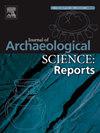使用便携式拉曼、pXRF、傅立叶变换红外和近红外对独山玉进行现场非破坏性鉴定
IF 1.5
2区 历史学
0 ARCHAEOLOGY
引用次数: 0
摘要
独山玉被誉为中国 "四大名玉 "之一,声名远播,但人们对它的历史用途却了解甚少。由于缺乏对古代独山玉器的科学分析,导致其历史用途相当模糊。要弥补这一缺陷,科学鉴定势在必行。鉴于疑似独山玉器的数量众多,一种快速、便携的分析方法至关重要。在这项研究中,我们采用了便携式拉曼光谱、X射线荧光、傅立叶变换红外和近红外设备,对南阳盆地三个仰韶文化遗址出土的古代独山玉样品进行了分析,并与现代独山玉标本进行了对比。拉曼光谱成功地在古代和现代样品中鉴定出了阳起石和黝帘石,与当代独山玉的矿物学定义相一致。元素分析显示,主要成分为 SiO2、Al2O3、CaO 和 Fe2O3,微量元素包括 V、Cr、Co、Ni、Cu、Sr 和 Ba。红外光谱也显示出与阳起石和黝帘石的相似性,并在特定波段观察到明显特征。重要的是,古代样品的指标与现代独山玉的指标一致,证实了成分的一致性和这些识别标志的可靠性。来自不同地点的材料表明独山玉器在南阳盆地分布广泛。利用更广泛的数据开展进一步研究,可以揭示中原地区玉文化的形成和演变过程,从而凸显本研究在推进我们对独山玉认识方面的重要意义。本文章由计算机程序翻译,如有差异,请以英文原文为准。
On-site non-Destructive identification of Dushan jade using portable Raman, pXRF, FTIR, and NIR
Dushan jade, renowned as one of China’s ‘Four Famous Jades’, has a storied reputation, yet its historical application remains inadequately understood. The lack of scientific analysis of ancient Dushan jade artifacts has led to considerable ambiguity regarding its historical use. To address this gap, scientific identification is imperative. Given the extensive number of suspected Dushan jade artefacts, a rapid and portable analytical approach is essential. In this study, we employed portable Raman spectroscopy, X-ray fluorescence (pXRF), Fourier-transform infrared (FTIR), and near-infrared (NIR) devices to analyze ancient Dushan jad samples from three Yangshao culture sites in the Nanyang Basin and to compare them with modern Dushan jade specimens for comparison. Raman spectroscopy successfully identified anorthite and zoisite in both ancient and modern samples, consistent with the contemporary mineralogical definition of Dushan jade. Elemental analysis revealed that the primary components were SiO2, Al2O3, CaO, and Fe2O3, while the trace elements included V, Cr, Co, Ni, Cu, Sr and Ba. Infrared spectra also showed similarities to anorthite and zoisite, with distinctive features observed in specific bands. Importantly, the indicators from ancient samples align with those of modern Dushan jade, confirming that consistency of composition and the reliability of these identifying markers. The presence of materials from diverse locations suggests a broad distribution of Dushan jade artifacts within Nanyang Basin. Further research with more extensive data could illuminate the formation and evolution of jade culture in the Central Plains, highlighting the significance of this study in advancing our understanding of Dushan jade.
求助全文
通过发布文献求助,成功后即可免费获取论文全文。
去求助
来源期刊

Journal of Archaeological Science-Reports
ARCHAEOLOGY-
CiteScore
3.10
自引率
12.50%
发文量
405
期刊介绍:
Journal of Archaeological Science: Reports is aimed at archaeologists and scientists engaged with the application of scientific techniques and methodologies to all areas of archaeology. The journal focuses on the results of the application of scientific methods to archaeological problems and debates. It will provide a forum for reviews and scientific debate of issues in scientific archaeology and their impact in the wider subject. Journal of Archaeological Science: Reports will publish papers of excellent archaeological science, with regional or wider interest. This will include case studies, reviews and short papers where an established scientific technique sheds light on archaeological questions and debates.
 求助内容:
求助内容: 应助结果提醒方式:
应助结果提醒方式:


